Invest in sexual reproductive health

This week the world is celebrating World Population Day - a day that has been celebrated since 1989 to drive attention towards population issues and how they affect overall economic growth, health, the environment and many other world issues. Uganda this year is commemorating World Population Day under the theme: ‘Renewing the promise to empower Uganda’s youth to drive socio-economic transformation.’
This conversation is timely, given the factthat Uganda’s population remains largely young, constituting 78 per cent of the total population, according to the 2014 National Population Census.
Of course, this huge population presents two scenarios: If this population is harnessed, it can be turned into a productive force as a global outsourcing market. Uganda has a big educated work force capable of meeting the global demand of a skilled work force and in turn, greatly contribute to global development.
This is key since Uganda is working towards achieving middle income status by 2020 and must leverage its ever growing human capital. This puts the youthful population at the centre of driving this progress. Besides, a big youthful population has the potential to create social, economic and political problems if not managed well. Uganda’s ever-growing contraception need is one such problem.
Many young people continue to face significant (sexual and reproductive health and rights (SRHR) challenges such as limited access to youth-friendly health services, including information on SRHR and family planning.
According to a 2018 study done by Guttmacher Institute titled; “Adding It Up: Investing in Contraception and Maternal and Newborn Health for Adolescents in Uganda,” an estimated 648,000 women aged 15 to 19 in Uganda are sexually active and did not want a child in the next two years. However, among this group, more than 60 per cent had an unmet need for modern contraception, meaning that they either did not use any contraceptive method or used a traditional method of contraception.
Subsequently, Uganda is faced with SRHR-related issues, including teenage pregnancy. The 2016 Uganda Demographic Health Survey indicates that 25 per cent (one in four girls) between the ages of 15 to 19, have either began childbearing or have already had a child. This is exacerbated by the prevalence of risky sexual behaviour among young people resulting in high STI and HIV prevalence, among other things. With evidence showing that behaviourial change is more likely to happen at an earlier stage, the government has developed a number of policies that address some of these SRHR concerns. They include the National Adolescent Health Policy, the National Framework on Sexuality Education and the National School Health Policy.
Attempts to expedite the passing and implementation of these policies has not been prioritised, which has left young people with few options when trying to meet their SRHR needs. The effect of this with reference to the above-mentioned statistics is that young people are constantly in a dilemma on how and where to access accurate and relevant information on adolescents and young peoples’ sexual reproductive health and rights.
Therefore, to change this narrative, critical investments ought to be made now to protect young people’s access to sexual reproductive health and rights. This can be done through passing and implementing policies such as the School Health Policy that provides the youth with an opportunity to access the much needed SRHR information to make decisions that can influence their overall future.
Humphrey Nabimanya,
[email protected]




